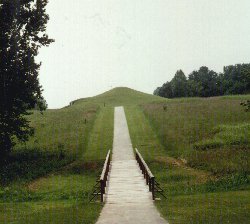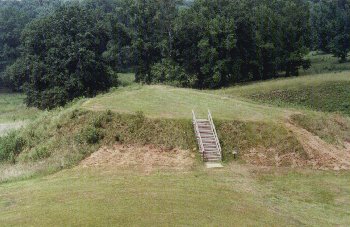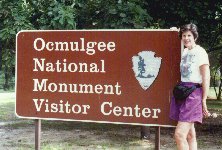| A
Visit to Ocmulgee National Monument |
 |
This is a park dedicated to preserve the remains of the earthen mounds built hundreds of years before the first European arrived to this continent, by a prehistoric culture of North America known as the Early Mississippian.
The Monument is located in what the scientists call the Macon Plateau in central Georgia. Between AD 900 and 1100 a skillful farming people lived in this area. Apparently, they were not the first inhabitants of this land. The Mississippians displaced the native woodland Indians that occupied the region between 1000 BC and AD 900 until the arrival of the Mississippians, although, they still remained in the area for a while. The Mississippians cultivated corn, beans, squash, pumpkins, and tobacco.
 Probably
more than a thousand people lived here at one time in a compact town of
thatched huts on the bluff overlooking the Ocmulgee River. They leveled
part of the ground near the river and built a series of earth mounds. The
mounds were probably constructed at different stages and they had different
purposes: temples, burial grounds, meeting places, etc.
Probably
more than a thousand people lived here at one time in a compact town of
thatched huts on the bluff overlooking the Ocmulgee River. They leveled
part of the ground near the river and built a series of earth mounds. The
mounds were probably constructed at different stages and they had different
purposes: temples, burial grounds, meeting places, etc.
In Ocmulgee, as you exit the Visitor Center, you will see first an Earthlodge that probably was a meeting place for the town's political and religious leaders (see the photo above). This is a reconstruction of an original building. The pottery display shown at the top of this page is located inside this Earthlodge. The original clay floor is about a thousand years old.
 A
trail connects most of the features of this park. Also, you can take your
car and visit various of the mounds in the south section of the monument.
We recommend that you made a stop at one of the parking lots and visit
the Great and Lesser Temple Mounds. Not much is known about these two mounds,
except that they were topped by rectangular wooden structures and probably
used for important religious ceremonies. The Great Temple Mound is the
largest Mississippian mound on the Macon Plateau. The photograph above
shows the Lesser Temple as seen from top of the Great Temple. Before taking
your car again, you should go down the trail to the swampy lowlands of
the Walnut Creek.
A
trail connects most of the features of this park. Also, you can take your
car and visit various of the mounds in the south section of the monument.
We recommend that you made a stop at one of the parking lots and visit
the Great and Lesser Temple Mounds. Not much is known about these two mounds,
except that they were topped by rectangular wooden structures and probably
used for important religious ceremonies. The Great Temple Mound is the
largest Mississippian mound on the Macon Plateau. The photograph above
shows the Lesser Temple as seen from top of the Great Temple. Before taking
your car again, you should go down the trail to the swampy lowlands of
the Walnut Creek.
At the end of the main road there is a Funeral Mound. Approximately 100 burials have been uncovered here, many with shell and copper ornaments. Probably these are the remains of the village leaders.
The monument offers other points of interest such as two lines of prehistoric trenches, a trading post built around 1690 by English traders, the village site, as well as other earth mounds.
![]()
 Information:
Information:Address:
Ocmulgee National Monument
1207 Emery Highway
Macon, Georgia 31201
Tel: (912) 752-8257
This is a photo of my wife Niní, by the entrance sign
The Monument is open daily from 9:00 a.m. to 5:00 p.m. (Closed Christmas and New Years Day). There are no admission fees. The Visitors Center has a good archeological museum, exhibits, film as well as a gift shop and a Native American Art Gallery.
Please visit the Official Web page of the National Park Service indicated below for more details about this Monument.
![]()
Photographs - © 1996 Antonio
Fernández
To return
to the Main
Page |
Please,
share with us your opinions and suggestions: |
![]()
This page hosted by ![]() Get your own Free Home Page
Get your own Free Home Page